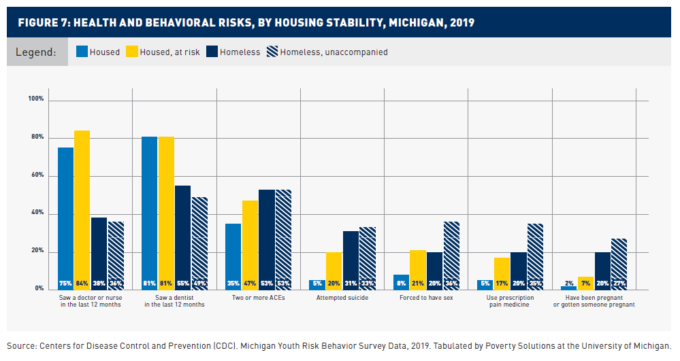Homeless, unaccompanied youth face significant health risks, lack access to shelter

Contact: Mara Ostfeld, 734-764-3490, mostfeld@umich.edu
Jared Wadley, 734-834-7719, jwadley@umich.edu
ANN ARBOR—High school-aged youth experiencing homelessness report higher rates of attempting suicide, being forced to have sex, misusing prescription pain medication, and pregnancy than their housed peers. Transgender youth are especially at risk of experiencing homelessness and being estranged from a parent or guardian.
That’s according to new analysis from University of Michigan’s Poverty Solutions initiative, which aims to prevent and alleviate poverty through action-based research. The analysis estimates the total number and ages of high school youth who face homelessness in Michigan, their health risks, and their use of support services in the last 12 months, using data from the Michigan Department of Education, Michigan’s 2018 Annual Report on Ending Homelessness, and the 2019 Youth Risk Behavior Survey (YRBS); this is the most recent data available.
“We found that the likely number of homeless unaccompanied minors in Michigan is much higher than shelter or school data suggest. Data also show that homeless youth face much higher risks to their health and well-being and are accessing primary health care at much lower rates than their housed peers,” said Jennifer Erb-Downward, senior research associate at Poverty Solutions who specializes in child and family homelessness. Erb-Downward co-authored a policy brief summarizing the data analysis, titled “A Way Home: Why Supporting Youth Experiencing Homelessness is Critical in Michigan.”
In 2019, 5.6% of Michigan high school youth reported being homeless in the last 30 days. This is the equivalent of an estimated 22,444 teens without a stable place to live across the state. This issue is especially pronounced among youth who identify as transgender. More than 1 in 4 (26%) transgender youth reported being homeless or at risk for homelessness compared to just over 1 in 10 (11%) of their peers who do not identify as lesbian, gay, bisexual, transgender, or queer (LGBTQ). Of particular note, 9% of transgender high school youth reported experiencing homelessness unaccompanied by a parent or guardian — a rate more than four times that of youth who did not identify as LGBTQ (2%)
In all, over one-third (37.8%) of youth who were homeless in the last 30 days reported that they had run away from home, been kicked out, or abandoned in the last 30 days – meaning they were unaccompanied by an adult and without a stable place to live. At least 6,400 of these youths were minors ages 17 or younger.
Poverty Solutions’ analysis also found the vast majority of homeless, unaccompanied minors in the state are not accessing shelter supports. In 2018, Michigan youth shelters reported serving 711 homeless, unaccompanied minors — the equivalent of just 11% of unaccompanied minors estimated to be experiencing homelessness in Michigan in 2019.
Homeless youth were five times more likely to have attempted suicide, four times more likely to currently misuse prescription pain medicine, three times more likely to have been forced to have sex, and 11 times more likely to have been or gotten someone pregnant than their housed peers. Only one-third (37.2%) of homeless youth reported seeing a doctor or nurse in the last 12 months compared to three-quarters (75.7%) of housed youth.
“Unfortunately, these data show that far too many minors are experiencing homelessness while not receiving the support that they need. However, changes to state policy and homeless services can make it easier for youth to access shelter and health care,” said Amanda Nothaft, senior data and evaluation manager at Poverty Solutions who co-authored the policy brief.
The brief outlines policy recommendations to expand and strengthen shelter and transitional living services for youth experiencing homelessness, make it possible for unaccompanied minors to consent to shelter services and basic medical care, provide support to families facing housing instability to prevent them from becoming homeless, and strengthen support for youth transitioning out of foster care and juvenile justice.
